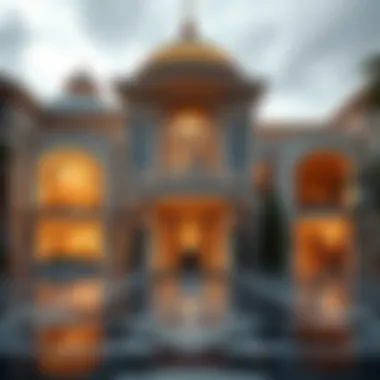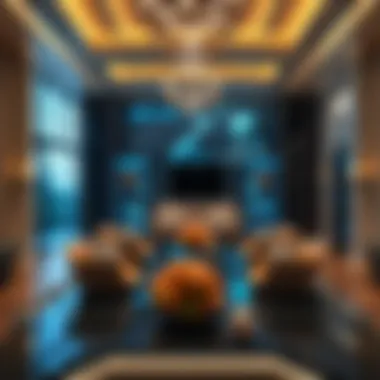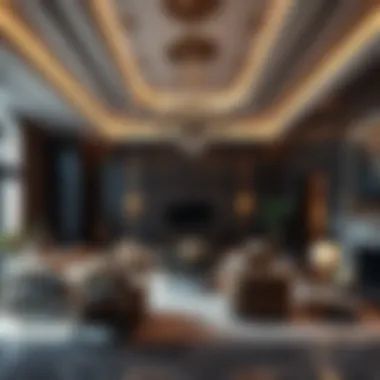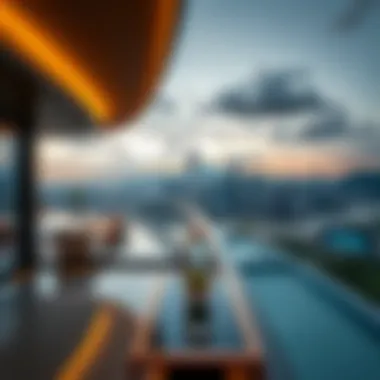Trillionaire Residences: A Deep Dive into Ultra-Luxury Living


Intro
Trillionaire residences represent the apex of luxury living, showcasing attributes that extend far beyond mere opulence. These homes are not just places to live; they exemplify a lifestyle characterized by unparalleled sophistication, cutting-edge technology, and significant socio-economic implications. In a world where wealth concentration is reaching astronomical heights, the design and functionality of these estates speak volumes about the direction in which luxury real estate is headed.
In examining this phenomenon, it’s essential to explore the architectural grandeur that defines these properties. From eco-friendly innovations to tech advancements that redefine comfort, every aspect is meticulously crafted to cater to the demands of those who can afford it. However, this exploration does not stop at mere aesthetics. The socio-economic ramifications of such extravagant living can be quite profound, shaping local markets and communities in unexpected ways.
This article aims to provide a comprehensive guide on trillionaire residences, offering insights into their characteristics, market trends, and architectural philosophies. By delving into specific regions known for high-end properties—like Dubai and Monaco—we reveal how unique locales influence design choices and the overall appeal of these homes.
As we embark on this journey, we’ll unpack essential topics ranging from current market analysis to future predictions, providing investors, realtors, homebuyers, and developers with the tools they need to navigate this niche real estate sector. Buckle up as we dive deep into the world of ultra-luxury living—a realm where every detail matters, and the possibilities are as vast as the wealth behind them.
Foreword to Trillionaire Residences
Understanding trillionaire residences opens a window into an unparalleled realm of luxury living that remains elusive to most. These residences are not just homes; they are symbols of wealth, innovation, and design excellence, crafted for an elite class that contemplates aesthetics and space differently.
In an era where the concept of home is evolving, it is crucial to examine the layers behind such grand structures. A trillionaire residence often embodies years of architectural development, incorporating trends that define luxury through each decade. It’s about more than marble countertops and expansive square footage; it’s the convergence of art, technology, and sustainability that sets these properties apart.
Historical Context and Emergence
The landscape of ultra-luxury living began to shift dramatically in the late 20th and early 21st centuries. As global wealth became more concentrated, particularly among tech entrepreneurs and financial magnates, the demand for exclusive living spaces surged. Properties that once catered solely to luxury buyers began to morph into something far more elaborate. With the rise of cities like Dubai and Hong Kong as super-hubs of wealth, developers started to experiment with ambitious designs, leading to the emergence of luxury skyscrapers, sprawling estates, and private islands.
Interesting fact: In 2018, the world saw a notable spike in luxury home prices, which increased by 4% year-on-year. A reflection not just of increased wealth, but of the limited availability of prime real estate. This historical backdrop provides the context necessary to understand why billionaires and trillionaires pursue land and space in locations such as Monaco, Silicon Valley, and Dubai.
Defining Trillionaire Residences
Defining what constitutes a trillionaire residence requires delving into specifics that extend beyond mere square footage. These homes are characterized by:
- Exclusivity: It isn't enough for a residence to be luxurious; it must also be rare, often existing in singular locations that offer stunning views or unique environments.
- Design: Tailored by top architects, these homes encompass innovative features, from geo-thermal heating to walls that literally change colors with the seasons.
- Integration of Lifestyle Amenities: This includes private cinemas, art galleries, or even underground car parks designed for rare collectibles.
By examining these defining traits, one realizes that a trillionaire residence isn’t just a dwelling; it's an experience curated to guarantee comfort, security, and sometimes, an escape from the world. The significance of billionaires seeking such unique properties speaks volumes about our times, attitudes, and the ever-changing fabric of wealth.
Architectural Distinction
The architecture of trillionaire residences stands as an emblem of personal expression and societal aspiration, woven with threads of creativity, technology, and exclusivity. In many ways, these structures aren't just homes but rather artistic masterpieces reflecting the owner's stature and taste. The importance of architectural distinction in such residences is multifaceted; it melds aesthetics with functionality while simultaneously embodying luxury. For investors and developers, understanding this aspect can open doors to substantive value, driving up potential returns through unique design elements that can set a property apart in an increasingly saturated luxury market.
Iconic Designs from Leading Architects
When discussing iconic designs associated with trillionaire residences, one must first look to the luminaries of the architectural world. Names like Zaha Hadid, Frank Gehry, and Bjarke Ingels have become synonymous with groundbreaking design, pushing boundaries that redefine residential architecture.
Each of these architects brings a unique flair to lavish living spaces. Zaha Hadid’s works, characterized by organic forms, often resemble flowing water or wind, encapsulating a blend of nature and modernity. On the other hand, Frank Gehry’s deconstructivist approach transforms residences into playful, distorted shapes full of sharp angles and unexpected materials.
One example of this is the house designed by Gehry in Santa Monica, California, which merges art with residence. This architectural marvel is not just a dwelling; it's a statement piece that exemplifies wealth and creativity, driving desire among ultra-wealthy homeowners who seek something more than just a place to live.
"Great architecture is like great dance; it stirs emotions and inspires actions."
Investors looking at trillionaire residences should weigh heavily the architect's reputation and past work, as proven designs often invoke wider interest and can appreciate faster due to established desirability.
Integration of Natural Elements
The fusion of natural elements into architectural design has taken precedence in recent years, and it's particularly noticeable in billionaire residences. Properties that effortlessly blend the interior with the exterior demonstrate an understanding of both luxury and sustainability.
Take the example of residences that embrace the concept of biophilic design, which encourages an inherent connection to nature. Homes situated in verdant locales often boast vast glass facades, allowing light to flood interiors while providing stunning vistas of nature. Using sustainable materials such as reclaimed wood and locally-sourced stones not only aligns with ethical considerations but also enhances the home’s eco-footprint.
Incorporating features such as living green walls, rooftop gardens, and natural water features can elevate a property’s value significantly. These elements cater not just to aesthetic preferences but also offer tangible benefits like improved air quality and increased property value.
In summary, the architectural distinction of trillionaire residences showcases a blend of artistic design and functionality that resonates deeply with both consumers and investors alike. Whether it's through the mind-bending creations of famed architects or the harmonious integration of nature, these homes redefine what luxury living entails. Investors with an eye for architectural innovation can, in turn, navigate a thrilling landscape of opportunity by prioritizing distinctiveness and sustainability.
Technological Innovations
When discussing trillionaire residences, one cannot overlook the profound impact of technological innovations. These homes not only reflect the wealth of their owners but also serve as a testament to cutting-edge advancements that redefine luxury living. The convergence of design and technology has paved the way for domestic environments that cater not only to comfort but to sustainability, security, and convenience. In a world increasingly dependent on digital networks, the integration of sophisticated technologies transforms how affluent individuals experience their homes.
Smart Home Integration
Smart home technology has revolutionized residential living—especially in spaces designed for the ultra-rich. Imagine walking into a room where the lights adjust automatically according to your mood or preferences, and the temperature is regulated precisely to your liking, all with just a voice command or, even better, through an app on your smartphone. These features exemplify the convenience and luxury that smart homes can provide.
- Centralized Control Systems: At the heart of these installations, centralized control systems, like Google Nest or Apple HomeKit, allow residents to manage various devices seamlessly—from security cameras to home entertainment systems.
- Automated Security: Security is one of the paramount concerns in ultra-luxury homes. Systems that integrate facial recognition technology, motion detectors, and automated access can be crucial. This era’s vulnerabilities demand high-tech solutions that create peace of mind.
- Adaptive Environments: Advanced sensors can detect occupancy, days of the week, or even weather conditions to adapt the environment—adjusting lights, opening or closing windows, and managing climate control without any input from the homeowner.


These features not only make life easier but also save energy—an increasingly important factor in eco-conscious investment decisions. What’s more, the more home technology can learn and adapt, the more personalized and efficient the living experience becomes.
Sustainable Technologies
In a time when sustainability has leapt to the forefront of conversations on luxury living, it's no surprise that technological innovations have been harnessed to promote eco-friendly practices. Trillionaire residences increasingly integrate sustainable technologies that serve the dual purpose of luxury and environmental mindfulness.
- Renewable Energy Sources: Many of these expansive homes are outfitted with solar panels or wind turbines. These features not only drive down energy costs over time, they also contribute to a greener future. Such investments signal to the public and the market that the owner is ahead of the curve in environmental stewardship.
- Water Conservation Systems: Advanced plumbing that recycles gray water for irrigation, alongside smart home controls that monitor water usage in real-time, are becoming standard. Not only is this responsible, but it also reflects a homeowner’s commitment to sustainable practices.
- Smart Insulation Technology: High-quality insulation paired with adaptive materials that respond to external temperatures can dramatically reduce energy consumption. With climate control becoming such a significant part of luxury homes, these innovations can make a huge difference.
The trajectory of sustainability and technology in trillionaire residences doesn’t just suggest a trend; it signals a deeper understanding of the interconnectedness between resource conservation and opulence. As more homes embrace these technologies, the concept of luxury evolves toward greater responsibility—echoing the beliefs of a new generation that prizes unique amenities alongside ecological efficiency.
The intersection of technology and sustainability reshapes how affluent individuals view ownership—transforming homes into statements of both personal and environmental responsibility.
Ultimately, the technologies that enhance luxury living in trillionaire residences reflect broader societal trends. They cater to a clientele that not only demands the pinnacle of comfort and security but also seeks to leave a positive mark on the planet.
Location and Exclusivity
The significance of location is paramount when it comes to trillionaire residences, as it directly influences both value and desirability. These homes are not just about luxurious floors or expansive swimming pools; they are also about being situated in strategic, breathtaking locales that signify status and offer unparalleled lifestyle benefits. The exclusivity factor adds another layer, ensuring that these properties are set apart from the bustling world outside, allowing wealthy owners to retreat into plush enclaves of security, comfort, and prestige.
Prime Locations Around the Globe
When discussing prime locations worldwide, a few areas simply command attention. Cities like Monaco, New York City, and London have long held their ground as hotspots for the ultra-wealthy. Each of these places offers distinct charms:
- Monaco: Known for its Mediterranean climate, this tiny principality is renowned for its grand casino and yacht-filled harbor. The real estate is at a premium here, with breathtaking views of the sea and luxury shopping just a stone's throw away.
- New York City: The bustling streets of Manhattan hold some of the world’s most coveted real estate. From skyscrapers in Manhattan to historic brownstones in Brooklyn, the appeal of proximity to major cultural and financial centers is undeniable.
- London: Home to historic landmarks and a robust financial sector, neighborhoods like Mayfair and Kensington represent some of the most sought-after addresses.
Beyond these cityscapes, several emerging locations are giving the traditional luxury hotspots a run for their money. Think of places like Singapore and Shanghai where skyscrapers touch clouds and luxury is defined by contemporary architecture melded with rich culture.
The Allure of Dubai as a Trillionaire Hub
Dubai epitomizes the modern concept of luxury living. With its tax-free status and a skyline dotted with architectural marvels, it has become a coveted destination for many seeking those trillionaire residences. The city offers a unique blend of cultural diversity, luxury shopping, and entertainment, making it not just an abode, but a lifestyle.
Factors contributing to Dubai’s allure include:
- Strategic Location: Situated at the crossroads of Europe, Asia, and Africa, Dubai serves as a central hub for business and travel.
- Luxury Amenities: From five-star hotels to lavish shopping malls, the city invests heavily in creating an environment of excess. The Burj Khalifa and Palm Jumeirah are just a taste of this wealth of opulence.
- Safety and Stability: Dubai's reputation for political stability and safety appeals to ultra-high-net-worth individuals concerned about the fluctuating conditions in other regions.
Investment in Dubai’s real estate market has been rising, aided by a shift aimed toward creating a competitive landscape for global wealth. This city is more than just a place to live; it's a statement of wealth and aspiration.
"Real estate is not just about bricks and mortar. It's about community and culture."
In summary, the factors of location and exclusivity play a critical role in shaping the landscape of trillionaire residences. As buyers search for both security and status, they gravitate toward areas that not only meet their investment needs but also match their lifestyles. As these trends continue, locations like Dubai will likely further cement their status as beacons of ultra-luxury living.
Market Dynamics
Understanding the market dynamics of trillionaire residences is crucial for various stakeholders, from investors to realtors, and even homebuyers. This segment not only sheds light on current trends but also sets the stage for evaluating the future of luxury living among the ultra-wealthy. It creates a roadmap for potential buyers and those looking to invest or develop properties in this niche segment of real estate.
The interplay of location, demand, supply, and economic factors influences the market for these residences. Here are key elements to consider:
- Location Premium: Properties in top-tier locations, known for their exclusivity and amenities, command higher prices. Cities like Dubai, New York, and London are gold mines for such investments. The geographical desirability often leads to increased property value.
- Social Influences: The tastes and preferences of wealthy buyers shift over time. Recently, there's been a growing trend towards eco-friendliness, prompting developers to integrate sustainable features in construction. This responsiveness to buyer identity is vital in developing a property that aligns with market demand.
- Global Economic Trends: Fluctuations in currency values, political stability, and economic policies across nations can have a significant impact on investment in luxury real estate. A strong economy typically sees increased investment in high-end properties.
- Technological Advances: Smart home technologies are becoming a prerequisite. Buyers now expect properties equipped with top-of-the-line security systems, energy efficiency capabilities, and integrated home management tools. These could sway buyer decisions heavily.
"Investing in trillionaire residences is not just about the purchase—it's about aligning with global trends and the evolving tastes of a new class of buyers."
Recognizing these dynamics paves the way for potential investors and stakeholders to make informed decisions. By keeping an ear to the ground, it's possible to navigate the complexities of this ultra-exclusive market successfully.
Trends in Luxury Real Estate
The landscape of luxury real estate is constantly evolving, with new trends emerging that reshape what buyers expect from their homes, especially for the ultra-wealthy demographic.
- Health and Wellness Features: More than just a luxury, attributes like on-site gyms, spas, and wellness centers are quickly becoming essential. The well-to-do are investing in their health through their living spaces.
- Customization: A significant trend is the demand for tailored experiences in home design. Buyers are not just purchasing a house; they seek unique attributes that reflect their personality and lifestyle, often engaging renowned architects and designers.
- Community Amenities: Exclusive residences now include communal spaces for social interactions, such as rooftop gardens, lounges, and multi-use facilities that encourage a sense of community among residents.
- Adaptive Reuse: There’s a growing fascination with transforming historic or industrial buildings into luxury spaces. This creates a unique blend of old-world charm with modern comfort.
Understanding these trends is essential for any investor looking to step into the luxury real estate arena.
Investment Potential and Challenges
Investing in trillionaire residences can be a lucrative venture, but it comes with its own set of challenges.
Potential Benefits:
- High Returns: Properties in prime locations tend to appreciate significantly. Historical data shows increases in property values over the long term, making them an attractive investment.
- Draw of Exclusivity: Limited availability often means that these properties maintain their value even in fluctuating markets.
- Luxury Affordability: While it may seem counterintuitive, some trillionaire residences may seem overpriced, they are frequently viewed as opportunities for wealth preservation rather than conventional investments.


Challenges to Consider:
- Market Volatility: Economic downturns can affect even the high-end market. Prices can slump, resulting in losses for investors.
- Legal Complications: Navigating the varied international property laws can pose difficulties, especially when acquiring properties in different countries.
- Maintenance Costs: High-end properties often come with high upkeep costs, which need to be factored in as an ongoing financial commitment.
Investors must weigh these considerations carefully while strategizing how to enter this market effectively. A keen awareness of market dynamics can provide the groundwork for success in ultra-luxury living.
Economic Considerations
Understanding the economic considerations surrounding trillionaire residences is essential. These homes reflect the peak of opulence and represent significant investments impacting broader economic landscapes. The dynamics of wealth concentration in luxury real estate, coupled with local spending patterns, present an intricate narrative worth unpacking. It’s not just about where the money goes, but also about how it shapes surroundings, enhances communities, and dictates future developments.
Impact on Local Economies
The presence of trillionaire residences often brings substantial economic opportunities, albeit with mixed local sentiments. Firstly, these properties can boost local employment opportunities through construction and maintenance. Highly specialized skills are needed to build and service the unique features of such homes, meaning job creation extends to architecture, landscaping, security, and high-end hospitality.
Moreover, when ultra-wealthy individuals invest in properties, the surrounding businesses often flourish. Local luxury goods stores, fine dining restaurants, and service providers can see an uptick in patronage. For instance, high-end grocery chains and gourmet food producers may thrive in the vicinity, as residents seek premium products tailored to their lifestyle. Therefore, one could argue that local economies aren't just surviving; they’re thriving off the lavish lifestyle choices made by the ultra-rich.
Yet, not all that glitters is gold. As these residences rise, so does property value—sometimes to the detriment of local residents. Increased living costs can lead to gentrification, pushing long-term residents out of neighborhoods they have occupied for years. The delicate balance between economic benefits and social displacement becomes a contentious topic among community leaders.
"Luxury homes often become symbols of both aspiration and division. The wealth they represent can uplift or disrupt local economies depending on how well communities can adapt."
Tax Implications for Owners
When it comes to owning a trillionaire residence, the tax landscape is as intricate as the homes themselves. First off, high-value properties often bring about significant property taxes. Depending on the jurisdiction, these taxes can be a double-edged sword; they fund local services but can also raise communities' cost of living.
Various jurisdictions have different regulations concerning taxation. In some areas, property owners can enjoy tax incentives for implementing eco-friendly technologies within their homes, which is a considerable factor for many ultrarich homeowners keen on showcasing their commitment to sustainability. However, navigating these tax implications requires due diligence. Failing to understand local laws can lead to costly missteps, which could ultimately affect the investment's overall return.
Additionally, the question of inheritance tax rises for billionaires who intend to pass down these estates. It’s crucial to strategize long-term financial planning to mitigate hefty tax bills upon inheritance. Estate planning becomes imperative for maintaining wealth across generations.
Cultural Reflections
In the sphere of luxury real estate, the concept of cultural reflections is paramount. It encompasses how the lives, values, and aspirations of ultra-wealthy individuals manifest within their residential spaces. These mega homes are not simply places to live; they are statements of identity and power, a canvas that reflects personal beliefs, aspirations, and lifestyle choices. A residence owned by a trillionaire often serves as a microcosm of their achievements and societal contributions.
Understanding cultural reflections in these high-net-worth residences can offer invaluable insights into the mindset of affluent buyers and investors. It’s a dance of distinction that captures how wealth influences taste and what that says about broader societal trends. As these individuals curate environments filled with luxury and innovation, they also shape social norms, creating spheres of influence that extend beyond their walls.
Lifestyle Choices of the Ultra-Wealthy
The lifestyle choices made by the ultra-wealthy are often driven by a blend of privilege, opportunity, and the desire for exclusivity. For instance, consider a billionaire investing in a home with an expansive wine cellar designed to store vintage selections from Bordeaux or Burgundy. Such choices are more than mere indulgences; they communicate a deep appreciation for craftsmanship and connoisseurship, which are often the hallmarks of elite status.
Moreover, these residences are often equipped with state-of-the-art wellness features, reflecting growing trends toward health-conscious living. Spas, gyms, and meditation rooms can be found in many of these homes, indicating a prioritization of personal well-being. Additionally, outdoor spaces are frequently designed with lush gardens and serene water features, enhancing tranquility and privacy, which are essential for those leading high-profile lives.
- Customization is a significant trend. Many ultra-wealthy individuals commission bespoke designs that encapsulate personal aesthetics. This could mean integrating elements from various cultures, such as Asian Zen gardens paired with traditional European architecture.
- Technological advancements also play a crucial role—fully integrated smart systems that allow for controlling everything at the touch of a button, from lighting to security, underscore the value placed on convenience without sacrificing elegance.
- The choice of materials signifies status too. Exquisite marble from Italy or handcrafted wood from endangered species often dominate these palatial constructs, which brings forth discussions around sustainability and ethical sourcing that resonate with the elite today.
Art and Personal Expression in Mega Homes
Art is both a reflection of personal taste and a declaration of identity within the realm of trillionaire residences. Many ultra-wealthy homeowners choose to showcase extraordinary collections that include pieces from renowned artists or rare artifacts from historical significance. For them, investing in art is not just a financial decision; it's a way to create a narrative about who they are and what they value.
In fact, art galleries within homes are becoming a more common feature, blurring the lines between living spaces and curated exhibitions. This trend highlights the desire of many billionaires to host private viewings and social gatherings in settings that exude their taste and influence.
- Cultural representation is a vital aspect here, as many homeowners opt to feature artwork that signifies their heritage or interests, ranging from contemporary art to classic sculptures, thus creating vibrant dialogues between different cultures.
- Personal expression goes beyond merely displaying art. Many wealthy individuals commission bespoke works tailored to their personal stories, memories, or experiences, allowing them to intertwine their narratives with the visual allure of their properties.
As the boundaries of personal expression through art expand, these residences evolve into living museums, each telling a unique story that encompasses the homeowner's journey through life. The cultural reflections found within trillionaire residences not only highlight the lifestyles of the ultra-wealthy but also underscore the powerful messages they convey to the world.
Legal Aspects
The realm of trillionaire residences is not just about opulence and aesthetics; it also involves a complex web of legal considerations. These elements pertain not only to property ownership but also to regulations that govern the luxurious lifestyle and the high stakes of real estate transactions. Understanding these legal facets is crucial for investors, realtors, and developers looking to navigate the upper echelons of luxury living.
Ownership Regulations in Dubai
Dubai stands out as one of the premier destinations for ultra-wealthy individuals seeking luxurious homes. However, the legal landscape here can be a bit of a maze. In Dubai, property ownership laws primarily favor expatriates, allowing them to fully own properties in designated freehold zones. These areas, which include stunning skyscrapers and lavish villas along the coastline, offer a significant advantage for non-nationals.
However, it’s essential to mind the fine print. Buyers must be aware of the associated costs, such as transfer fees and registration, which can add up quickly. Furthermore, the local government imposes strict regulations to ensure that properties are maintained to a certain standard. This is especially important as dilapidation can affect property values and the overall aesthetic of luxury communities.
"Investing in Dubai real estate gives you a foothold in one of the fastest-growing markets globally, but understanding local regulations is paramount."
Additionally, obtaining necessary permissions for renovations or expansions can trip up even the savviest investor. With different zoning laws and building regulations in place, a thorough understanding is vital to avoid legal pitfalls that can lead to costly delays.
International Property Laws and Challenges


When it comes to properties in the trillionaire bracket that span different countries, international property laws add another layer of complexity. Each nation has its peculiarities regarding foreign ownership, inheritance laws, and tax obligations. Knowing the laws in one’s homeland is equally essential when investing abroad.
For instance, certain countries may implement restrictions on foreign ownership of real estate. In Japan, for example, while foreigners can purchase property, they might face hurdles related to obtaining financing or specific residency requirements. Likewise, legacy planning becomes a critical element in international real estate, especially for ultra-wealthy individuals wanting to pass on their assets efficiently.
Here are some of the significant challenges that arise in dealing with international property:
- Varying Ownership Models: Different countries may have leasehold arrangements rather than freehold tenure, complicating asset management.
- Inheritance Tax: Some regions impose heavy inheritance taxes on foreign owners, making estate planning crucial.
- Title Issues: Ensuring clear title and ownership can become challenging when properties are involved in multiple jurisdictions.
Navigating the international landscape of property ownership requires diligence and often the assistance of legal professionals. Familiarity with the regulatory environment of the desired country will not only help smooth the buying process but will also inform potential buyers about future implications, such as taxes and manageability.
In sum, legal aspects of trillionaire residences significantly impact potential owners and investors. An informed approach can avert pitfalls and enhance the investment experience, especially in dazzling hubs like Dubai or across international borders.
Psychological Impacts of Luxury Living
The phenomenon of luxury living, particularly in the context of residences owned by the ultra-wealthy, carries significant psychological implications. It is essential to understand how such lavish lifestyles shape social identity, elevate status, and influence behavior. These impacts go beyond mere opulence, highlighting deeper human needs and societal interactions.
Social Status and Identity
Living in a trillionaire residence is not just about having a roof over one’s head—it's a powerful statement of social status. For many affluent individuals, their homes serve as a reflection of their identity and achievements. The reality is that the architecture, interior design, and even the location of their residences contribute to their perceived self-worth.
- Public Perception: Prestige is often derived from the external perception of wealth. People tend to assign value and respect based on one's address. Notions such as ‘living on Fifth Avenue’ evoke an image of success and superiority. The more exclusive the location, the stronger the connection to high status.
- Personal Identity: The surroundings in which individuals dwell can profoundly affect their self-concept. For some, their residence becomes an extension of their identity. An opulent home filled with contemporary art and bespoke furnishings signals a lifestyle that is curated and distinctive, creating a personal brand that aligns with their socio-economic status.
- Comparative Standards: In a world where social media amplifies visibility, the race to showcase a life of luxury has ramifications on personal identity. Those who inhabit these lavish spaces may find themselves constantly comparing their lifestyle with others, perpetuating a cycle of validation based on material success.
In essence, the architectural grandeur and concentrated wealth within these residences do not merely serve as shelter; they symbolize success and social standing that underline deeper psychological needs.
Isolation vs. Community in Mega Residences
One might think that living in a grand estate would foster a deep sense of community; however, the reality can be strikingly different. The psychological impact of isolation versus community living in these mega residences is complex and multifaceted.
- Isolation Effects: Ultra-luxury living can often lead to feelings of seclusion. High walls, expansive spaces, and private amenities—while designed for comfort—might limit genuine social interactions. Residents may find themselves disengaged from their immediate surroundings, resulting in loneliness. It is not uncommon for billionaires to feel disconnected from everyday life, leading to a longing for more authentic social connections.
- Community Amenities: Despite the potential for isolation, many mega residences incorporate communal features—like shared gyms, theaters, and gardens—to foster a sense of community. While these amenities are attractive, they still can’t replicate the closeness found in less ostentatious neighborhoods where social interactions happen organically.
- Navigating Social Networks: The dynamics of community living can also be skewed. There’s a challenge of forming authentic relationships amidst a backdrop of wealth disparity. Residents may grapple with genuine friendships versus those rooted in interest or social gain. This social stratification can lead to complexities in emotional connections, again highlighting the sensitive interplay of luxury living and genuine human interaction.
"Luxury living can create an illusion of connection while fortifying barriers to authentic relationships."
These aspects highlight that while ultra-luxury residences can offer unparalleled comfort and prestige, they also raise questions about the nature of human connection and the pursuit of genuine satisfaction in one's social milieu.
In summary, the psychological impact of luxury living encapsulates both the celebration of status and the potential pitfalls of isolation. As such, understanding these nuances can help investors, realtors, and developers navigate the intricate landscape of ultra-luxury real estate.
Future Trends
The world of trillionaire residences is ever-evolving, constantly reshaped by socio-economic factors, technological advancements, and the changing tastes of the ultra-wealthy. Understanding future trends in this niche market is not just for the curious; it’s essential for investors, realtors, homebuyers, developers, and analysts keen on staying ahead of the curve. By exploring the upcoming transformations in housing preferences and technological integrations, stakeholders can anticipate shifts and seize emerging opportunities.
Evolving Designs for the Next Generation
The architectural landscape of trillionaire residences is undergoing a seismic shift. New design philosophies blend opulence with functionality, echoing the demands of modern aesthetics while integrating sustainable practices. For example, a trend towards modular designs allows for expansive spaces that can be easily reconfigured to suit varied needs. These homes emphasize free-flowing layouts that not only enhance luxury but also facilitate entertaining, family living, or personal retreats.
More than just aesthetics, the focus now extends to smart use of space. Innovations such as biophilic design, which incorporate natural elements like air and greenery indoors, are gaining traction. Take the MVRDV’s Tree House in Amsterdam as an example, where units are centered around trees, creating a harmonious living environment that promotes health and well-being. These designs not only appeal to the visual senses but also underscore a deep-rooted connection to nature—an element increasingly valued by grassroots millennials and billionaires alike.
Home features like retractable glass walls and outdoor living spaces are becoming standard for luxury residences, enabling seamless transitions between indoor and outdoor areas. This approach enhances not just comfort but also offers a stunning backdrop for those majestic views or secluded gardens that trillionaires often desire.
In short, the emerging designs of trillionaire residences embrace both luxury and sustainability—ideal for the next swirl of homeowners who value both aesthetics and environmental awareness.
Emerging Technologies in Real Estate
When we speak of emerging technologies, the evolution of trillionaire residences becomes even more fascinating. Homeowners today expect not only fluid design but also advanced smart home systems. Automation systems like those offered by Control4 or Crestron are becoming the norm; providing intuitive control over lighting, climate, security, and entertainment systems right from a mobile device. With voice-activated home assistants, the concept of homeowner convenience is taken to an all-new level.
On the sustainability side, innovations in energy efficiency are coming into play. Smart technology can manage energy consumption dynamically, suggesting optimal usage patterns to reduce environmental impact. In residences powered by solar panels and generative energy systems, future billionaires can enjoy amenities guilt-free, lessening their carbon footprints while still living lavishly.
Moreover, with the advent of augmented reality and virtual reality, prospective buyers can virtually tour these properties from anywhere in the world. This not only saves time but can also be a game-changer when demonstrating the property’s potential. An article by Statista shows that nearly 70% of millennials prefer VR viewings when contemplating luxury real estate.
In summary, the emergence of these technologies shapes a new blueprint for trillionaire residences. It’s about more than just living large; it’s about living smart and responsively within a connected ecosystem.
The End
In contemplating the realm of trillionaire residences, one truly grasps the convergence of architecture, technology, and socio-economic dynamics that characterize these extravagant living spaces. As we peel back the layers of this topic, the essence becomes clear; these residences do not merely serve as homes, but as powerful symbols of wealth, status, and innovative ambition. Their significance stretches far beyond mere luxury, influencing local economies and shaping the real estate markets in profound ways.
The key insights drawn from this exploration emphasize the architectural brilliance and advanced technological integration that define these properties. They represent not just shelter, but also an embodiment of the aspirations and desires of their affluent inhabitants. The deliberate blending of sustainable features and eye-catching designs forms an essential narrative, revealing a shift in what luxury living means in the 21st century.
Moreover, understanding the implications of such wealthy neighborhoods on the broader economic landscape cannot be overstated. They often bring in substantial investment and can lead to both revitalization and gentrification in local communities. This presents a duality that potential buyers and investors must navigate—balancing personal desires with the greater good of the community.
What lies ahead in the future of wealth in real estate is equally compelling. Investors and developers will need to keep a vigilant eye on the evolving technological landscape as well as changing consumer values that increasingly prioritize sustainability and community. The nature of luxury is shifting, and early adopters of these trends may well find themselves on the winning side of tomorrow's market.
"As we move toward an age where technology and ecology entwine with opulence, trillionaire residences reflect a future that values substance over spectacle."
In summary, the exploration of trillionaire residences is not merely an investigation into extravagant living but a lens through which we can analyze the intersection of culture, economy, and personal identity. The reflections laid out here serve as a guide for investors, realtors, and developers, fostering a deeper understanding of the shifting landscape of ultra-luxury living.















